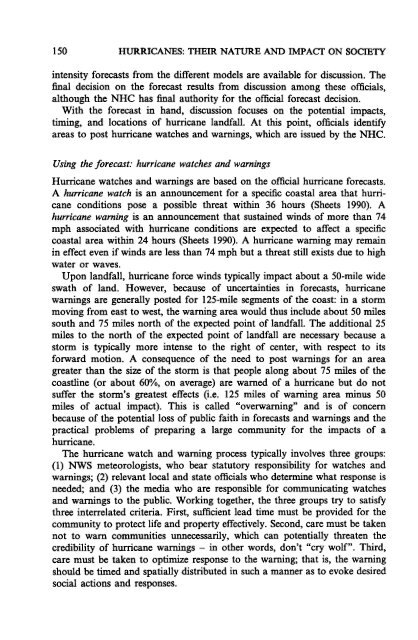Hurricanes: Their Nature and Impacts on Society - Climate Science ...
Hurricanes: Their Nature and Impacts on Society - Climate Science ...
Hurricanes: Their Nature and Impacts on Society - Climate Science ...
You also want an ePaper? Increase the reach of your titles
YUMPU automatically turns print PDFs into web optimized ePapers that Google loves.
150<br />
HURRICANES: THEIR NATURE AND IMPACT ON SOCIETY<br />
intensity forecasts from the different models are available for discussi<strong>on</strong>. The<br />
final decisi<strong>on</strong> <strong>on</strong> the forecast results from discussi<strong>on</strong> am<strong>on</strong>g these officials,<br />
although the NHC has final authority for the official forecast decisi<strong>on</strong>.<br />
With the forecast in h<str<strong>on</strong>g>and</str<strong>on</strong>g>, discussi<strong>on</strong> focuses <strong>on</strong> the potential impacts,<br />
timing, <str<strong>on</strong>g>and</str<strong>on</strong>g> locati<strong>on</strong>s of hurricane l<str<strong>on</strong>g>and</str<strong>on</strong>g>fall. At this point, officials identify<br />
areas to post hurricane watches <str<strong>on</strong>g>and</str<strong>on</strong>g> warnings, which are issued by the NHC.<br />
Using the forecast: hurricane watches <str<strong>on</strong>g>and</str<strong>on</strong>g> warnings<br />
Hurricane watches <str<strong>on</strong>g>and</str<strong>on</strong>g> warnings are based <strong>on</strong> the official hurricane forecasts.<br />
A hurricane watch is an announcement for a specific coastal area that hurricane<br />
c<strong>on</strong>diti<strong>on</strong>s pose a possible threat within 36 hours (Sheets 1990). A<br />
hurricane warning is an announcement that sustained winds of more than 74<br />
mph associated with hurricane c<strong>on</strong>diti<strong>on</strong>s are expected to affect a specific<br />
coastal area within 24 hours (Sheets 1990). A hurricane warning may remain<br />
in effect even if winds are less than 74 mph but a threat still exists due to high<br />
water or waves.<br />
Up<strong>on</strong> l<str<strong>on</strong>g>and</str<strong>on</strong>g>fall, hurricane force winds typically impact about a 50-mile wide<br />
swath of l<str<strong>on</strong>g>and</str<strong>on</strong>g>. However, because of uncertainties in forecasts, hurricane<br />
warnings are generally posted for l25-mile segments of the coast: in a storm<br />
moving from east to west, the warning area would thus include about 50 miles<br />
south <str<strong>on</strong>g>and</str<strong>on</strong>g> 75 miles north of the expected point of l<str<strong>on</strong>g>and</str<strong>on</strong>g>fall. The additi<strong>on</strong>al 25<br />
miles to the north of the expected point of l<str<strong>on</strong>g>and</str<strong>on</strong>g>fall are necessary because a<br />
storm is typically more intense to the right of center, with respect to its<br />
forward moti<strong>on</strong>. A c<strong>on</strong>sequence of the need to post warnings for an area<br />
greater than the size of the storm is that people al<strong>on</strong>g about 75 miles of the<br />
coastline (or about 60%, <strong>on</strong> average) are warned of a hurricane but do not<br />
suffer the storm's greatest effects (i.e. 125 miles of warning area minus 50<br />
miles of actual impact). This is called "overwarning" <str<strong>on</strong>g>and</str<strong>on</strong>g> is of c<strong>on</strong>cern<br />
because of the potential loss of public faith in forecasts <str<strong>on</strong>g>and</str<strong>on</strong>g> warnings <str<strong>on</strong>g>and</str<strong>on</strong>g> the<br />
practical problems of preparing a large community for the impacts of a<br />
hurricane.<br />
The hurricane watch <str<strong>on</strong>g>and</str<strong>on</strong>g> warning process typically involves three groups:<br />
(1) NWS meteorologists, who bear statutory resp<strong>on</strong>sibility for watches <str<strong>on</strong>g>and</str<strong>on</strong>g><br />
warnings; (2) relevant local <str<strong>on</strong>g>and</str<strong>on</strong>g> state officials who determine what resp<strong>on</strong>se is<br />
needed; <str<strong>on</strong>g>and</str<strong>on</strong>g> (3) the media who are resp<strong>on</strong>sible for communicating watches<br />
<str<strong>on</strong>g>and</str<strong>on</strong>g> warnings to the public. Working together, the three groups try to satisfy<br />
three interrelated criteria. First, sufficient lead time must be provided for the<br />
community to protect life <str<strong>on</strong>g>and</str<strong>on</strong>g> property effectively. Sec<strong>on</strong>d, care must be taken<br />
not to warn communities unnecessarily, which can potentially threaten the<br />
credibility of hurricane warnings -in other words, d<strong>on</strong>'t "cry wolf". Third,<br />
care must be taken to optimize resp<strong>on</strong>se to the warning; that is, the warning<br />
should be timed <str<strong>on</strong>g>and</str<strong>on</strong>g> spatially distributed in such a manner as to evoke desired<br />
social acti<strong>on</strong>s <str<strong>on</strong>g>and</str<strong>on</strong>g> resp<strong>on</strong>ses.














